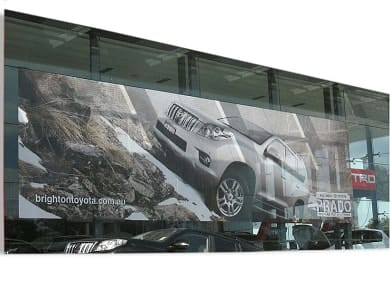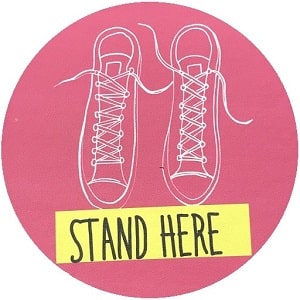
Today’s businesses and organisations have multiple ways to reach their customers such as Facebook, Google, TV, and Youtube. A lot of traditional marketing channels like Yellow Pages and newspapers have become obsolete.
How about signage? How effective are they in bringing in new customers and increasing sales? Here are three data points on that:
- Over 1 out of 2 customers have driven by and failed to find a business because the sign was too small or unclear.
- 1 out of 3 customers has been drawn into an unfamiliar store based on the quality of their signage.
- Almost 2 out of 5 customers have made an assumption on the quality of the business based on whether the signage is clear and attractive.
Here is a test
Below are two images of two different aquarium shops.
Which of these two aquarium stores do you think provide a better selection of fish and aquarium products and service?
Aquarium shop 1
Aquarium shop 2
Do you think the aquarium shop 1 or 2 provides a better quality product and service? If you are like us, we chose the one on the left.
According to a research done by Fedex, 7 out of 10 customers believe that a signage reflects the quality of a business and their product.
There are hundreds to thousands of people who have never dealt with you before and your sign will be the very first thing they see. A sign is like a handshake that makes the first impression to your potential customers.
That first impression is what draws in the customers and that is where the sales process begins. No matter how good your products and services are, if customers don’t walk in, call or search you on Google, you will have no opportunity at all to get the sale.
How small businesses think of signs
Most small businesses ignore the importance of a signage. The most common reasons that prevent them from investing in signage are:
- “My customers already know where I am.”
- “I already have a sign. I don’t need a new one.”
- “Can a sign improve my sales?”
According to Perry Powell, a signage consultant in the car wash industry, one of the most common mistakes by his clients is the money allocation when it comes to building in a new location. He says there is a mentality among small business owners where they allocate X amount of dollars in their budget to an item called “signs”. If the budget overruns during construction the first thing they cut are the signs.
It is almost similar to large corporations where they have a line in their budget called “marketing” and if the business starts to lose money, they cut marketing. Eventhough, marketing is one of the key components that generate customers in the first place.
How McDonald’s prioritise their signs
On the other hand, Perry’s larger clients such as corporations and franchises who understands signage think differently. One of them is McDonald’s. They recognise that a unique signage at their locations helps reinforce their brand into their customers’ minds.
To reinforce their brand, one of the very first things McDonald’s install at their new location is their signs.
Back to our previous point, your sign is the first impression you make to your potential customers. Most of the time, people do judge the quality of your product and service solely based on your sign.
Can signage bring in new customers?
Case Study 1: Hungry Jacks
Hungry Jacks conducted a survey on how their customers became aware of one of their restaurants. This survey was conducted over a period of a few months. Each customer that went in was asked how they first became aware of the restaurant.
Here are the results:
| How did you first became aware of the restaurant? | |
|---|---|
| Saw it while passing | 35% |
| Always knew it was there | 29% |
| Word of mouth | 14% |
| Advertising | 10% |
| Others | 6% |
| Don’t know | 6% |
The biggest percentage of their customers stopped by their restaurant on impulse. These are the 35% who selected “Saw it while passing”. On top of that, 29% who always knew it was there might have found out about the restaurant from the signage.
Case Study 2: Signtronix
Signtronix, a signage company did another study on whether signs can bring in new customers. Each business in the survey had a sign that was installed in the past 30 to 45 days. They then asked random first-time customers the question “How did you learn about us?”
Here are the results:
| How did you learn about us? | |
|---|---|
| Your sign | 46% |
| Word of mouth | 38% |
| Advertisements | 16% |
Out of 7,203 first-time customers, the survey revealed nearly 50% of their first-time customers found out about their business because of its sign.
Case Study 3: Major fast food chain
Another study on signage was done by the University of San Diego. The study analysed the effect of signage on a major fast-food chain.
The study measured the impact of several variables (including signage, location, hours of operation, population density and geographic characteristics) on sales at each of 162 locations of the fast-food chain.
Here are the results:
- The addition of one on-premise sign resulted in an increase of 4.75% of annual sales.
- One additional on-premise sign increased the annual number of customer transactions by almost 4%.
The results show that the number of signs on a particular site had a significant and positive impact on both annual sales and the number of annual customer transactions.
Case Study 4: National retailer
This study analysed seven years of weekly sales data for a national chain retailer of furniture and gift items. This study was conducted to find out the impact to sales if a signage was modified, added or removed.
Here are the results:
- When a new signage was added in a building without any signage, sales increased from 2.5% to 7.1%
- A new pole sign with the company’s name increased sales from 4.9% to 12.3%. Researchers attributed the sales increase to more visibility of the company’s new sign to passing traffic.
- Directional signs helped increased sales as well. These signs help shoppers find the entrance and exit routes. These signs increased weekly sales from 4.0% to 12.4%.
Case Study 5: A local bistro
Frenchy’s Bistro’s customers always referred to the restaurant as the one “near the paint store” since that paint store had a more eye-catching signage. Their sign was a small one-dimensional sign that was flat against the facade of the building. It was hardly visible to the passing traffic.
When sales stagnated, a friend of the owners suggested a new sign. They installed a new illuminated sign.
Here are the results:
- The illuminated sign increased sales by 16% in the first year and in their second year, sales continue to increase by another 32%.
- Frenchy’s later expanded into the shop next door and added an even larger sign and in four years, their overall sales increase by 322% to over $823,000.
Case Study 6: Car wash business
Belmont Auto Spa, a car wash business had a sign that was unreadable and can’t be seen by passing traffic. The owner wanted to attract more customers to their new detailing service. A new pole sign was installed that promoted their new service.
To help the owner achieve the goal of promoting their new detailing service, a pole sign was installed which cost $15,000.
Did the new pole sign increase sales?
Here are the results:
- Sales of their new detailing service increased by 125%.
- On top of that, overall sales increased by 15% which generated an additional $135,000 in sales in their first year.
- The sign paid for itself within six weeks.
Summary
Customers do judge the quality of your products and services of your business and organisation based on your signage. That sign is the first impression that you make with your customer and we all know how important a first impression is.
Signage has also been used to successfully bring in new customers and generate sales without the additional monthly expense such as TV or radio advertisements.
There is an old adage that says, “A business without a sign is a sign of no business.”










